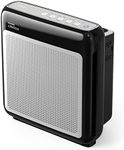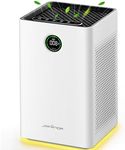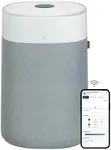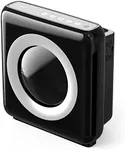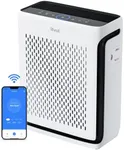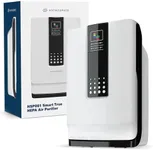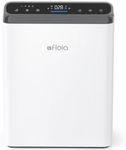Buying Guide for the Best Air Purifiers For Smokes
Choosing an air purifier for smoke can make a big difference in your indoor air quality, especially if you live with smokers, near wildfires, or in areas with poor air quality. The right air purifier will help remove smoke particles, odors, and harmful chemicals from the air, making your home healthier and more comfortable. To find the best fit, it's important to understand the key features and how they relate to your specific needs, such as room size, sensitivity to odors, and how often you plan to use the device.HEPA FilterA HEPA filter is a type of air filter that can capture very small particles, including those found in smoke. This is important because smoke particles are tiny and can easily pass through less effective filters. HEPA filters are rated to remove at least 99.97% of particles as small as 0.3 microns. When comparing air purifiers, look for 'True HEPA' filters, as these meet strict standards. If you are sensitive to smoke or have allergies, a HEPA filter is essential. For general use, a standard HEPA filter will suffice, but for heavy smoke, prioritize purifiers with advanced or medical-grade HEPA filters.
Activated Carbon FilterAn activated carbon filter is designed to absorb gases, odors, and volatile organic compounds (VOCs) that are present in smoke. This is important because while HEPA filters trap particles, they do not remove smells or chemicals. Activated carbon filters come in different thicknesses and amounts of carbon; thicker and heavier filters generally last longer and are more effective. If you are mainly concerned about smoke odors or chemical fumes, choose a purifier with a substantial activated carbon filter. For occasional smoke, a basic carbon filter may be enough, but for persistent smoke, opt for a model with a larger or more advanced carbon filter.
Clean Air Delivery Rate (CADR)CADR is a measure of how quickly an air purifier can clean the air of specific pollutants, including smoke. This is important because a higher CADR means the purifier can handle larger rooms or more intense smoke situations. CADR values are usually given for smoke, dust, and pollen, and are measured in cubic feet per minute (CFM). For small rooms, a lower CADR may be sufficient, but for larger spaces or heavy smoke, look for a higher CADR rating. Match the CADR to your room size and the level of smoke exposure for the best results.
Room Size CoverageRoom size coverage tells you the maximum area the air purifier can effectively clean. This is important because using a purifier that is too small for your space will not remove smoke efficiently. Manufacturers usually list the recommended room size in square feet or square meters. To choose the right one, measure your room and select a purifier rated for at least that size. If you have open floor plans or want faster cleaning, consider a model rated for a larger area than your actual room.
Filter Replacement IndicatorA filter replacement indicator is a feature that alerts you when it's time to change the filter. This is important because clogged or old filters lose effectiveness, especially when dealing with smoke. Some purifiers have simple lights, while others track filter life based on usage. If you want hassle-free maintenance, look for a model with a clear and reliable indicator. This is especially useful if you expect to use the purifier frequently or in high-smoke environments.
Noise LevelNoise level refers to how loud the air purifier is when running. This is important if you plan to use the purifier in a bedroom, office, or other quiet space. Noise is usually measured in decibels (dB), with lower numbers being quieter. Some purifiers have multiple speed settings, allowing you to choose a quieter mode at night. If you are sensitive to noise or need the purifier for a bedroom, look for models with low noise ratings or a dedicated sleep mode.

